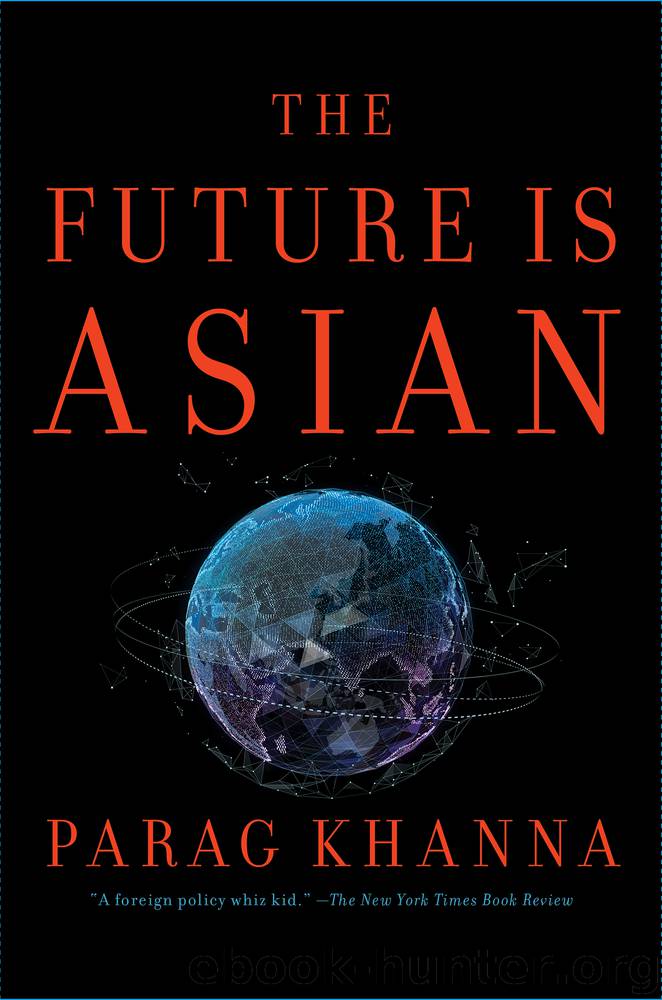The Future Is Asian by Parag Khanna

Author:Parag Khanna
Language: eng
Format: epub
Publisher: Simon & Schuster
Published: 2019-02-04T16:00:00+00:00
5
Asians in the Americas and Americans in Asia
The United States was founded by migrants from across the Atlantic, but in the nineteenth century Asians streamed in from across the Pacific. Filipinos were the first to arrive; their numbers steadily grew during the Philippines’ time as a US colony. The Chinese became the largest foreign-born Asian population, settling mostly on the West Coast, until the 1882 Chinese Exclusion Act. Fast-forward more than a century, and in 2010, Asia officially outstripped Latin America as the largest source of new immigrants into the United States.1 At the same time, Indians are the fastest-growing number of illegal immigrants, whether by overstaying their visas or by trying to enter the United States via Mexico.
Today 21 million US residents claim Asian heritage, the largest groups being Chinese (4.8 million), Indian (4 million), Filipino (4 million), Vietnamese (2 million), and Korean (1.8 million).2 There are also an estimated 3 million Americans of Arab descent. Arabs have been migrating to the United States for more than a century, with the metro Detroit area attracting the first wave of Lebanese, Syrian, Iraqi, and Yemenis, who worked first as shopkeepers and eventually in Ford’s automobile plants. The 1970s–’80s Lebanese civil war, the Persian Gulf War of 1990–91, and the invasion of Iraq in 2003 all continued to drive Arabs to Michigan even as the automotive industry declined as a major employer. Though the total number of Asians is just under half that of Hispanics, the gap is closing.3 Immigrants from Asia are granted twice as many green cards per year as those from any other region and are becoming citizens at twice the rate of other regions as well.4
Nearly half of all Asians in the United States live in the West, with California alone accounting for one-third. California has by far the largest number of Asians at nearly 7 million, followed by New York with 2 million.5 As a proportion of state populations, Hawaii leads the way with more than half (56 percent) of its residents of Asian heritage (primarily Filipinos and Japanese), followed by California (16 percent), then New Jersey, Nevada, and Washington, each of which is 10 percent Asian.6 Asians also have the highest rate of intermarriage (29 percent) of any ethnic group.7 By 2050, Asians are projected to displace Hispanics as the largest immigrant group, even though Latinos will still comprise a larger share of the total population.8
In recent decades, Asians have become much more visible in the American economy.9 But Asians’ incomes are as diverse as their ethnicity. Indians have the highest median household incomes, followed by Filipinos and Japanese, then Chinese, Pakistanis, and Koreans.10 As a whole, Asians have a median income approximately $19,000 higher than that of whites, who are the next most prosperous group. Arab Americans also have a higher median income than the general population, and Syrian refugees are quickly joining the labor force.
Given the size and wealth of the Indian diaspora, the Indian wedding industry alone contributes an estimated $5 billion per year to the US economy (more than the annual spending on weddings in India itself).
Download
This site does not store any files on its server. We only index and link to content provided by other sites. Please contact the content providers to delete copyright contents if any and email us, we'll remove relevant links or contents immediately.
50 Economics Classics by Tom Butler-Bowdon(2066)
Six Billion Shoppers by Porter Erisman(1999)
Why Nations Fail: The Origins of Power, Prosperity, and Poverty by Daron Acemoglu & James Robinson(1787)
No Time to Say Goodbye(1760)
The Economist [T6, 22 Thg9 2017] by The Economist(1644)
Red Notice by Bill Browder(1590)
Currency Trading For Dummies by Brian Dolan(1546)
Thank You for Being Late by Thomas L. Friedman(1455)
Bitcoin: The Ultimate Guide to the World of Bitcoin, Bitcoin Mining, Bitcoin Investing, Blockchain Technology, Cryptocurrency (2nd Edition) by Ikuya Takashima(1418)
Amazon FBA: Amazon FBA Blackbook: Everything You Need To Know to Start Your Amazon Business Empire (Amazon Empire, FBA Mastery) by John Fisher(1302)
The Great Economists by Linda Yueh(1186)
Coffee: From Bean to Barista by Robert W. Thurston(1180)
The Future Is Asian by Parag Khanna(1172)
Pocket World in Figures 2018 by The Economist(1155)
Capitalism Without Capital: The Rise of the Intangible Economy by Jonathan Haskel(1127)
Grave New World by Stephen D. King(1109)
How Money Got Free: Bitcoin and the Fight for the Future of Finance by Brian Patrick Eha(1097)
The Sex Business by Economist(1085)
Cultural Intelligence by David C. Thomas(1012)
